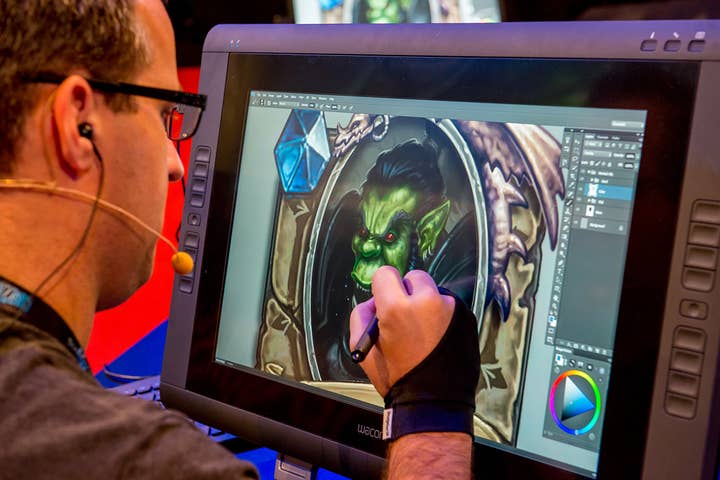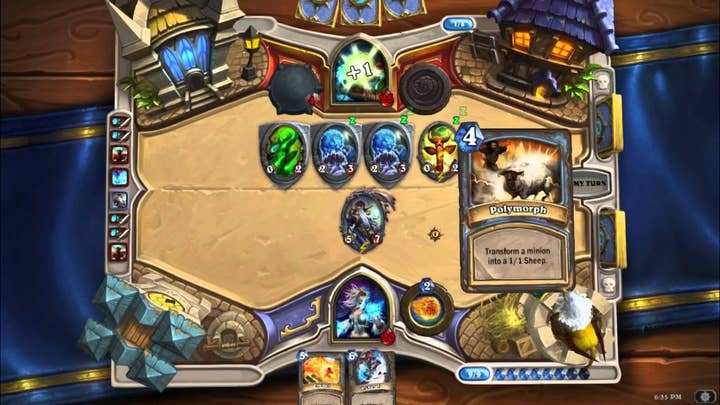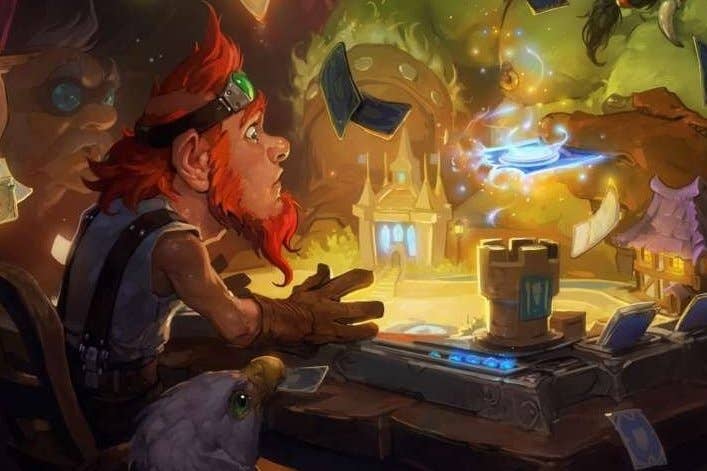Hearthstone and "white hat" free-to-play
Blizzard's Eric Dodds and Jason Chayes share their insights on money, eSports and fan feedback
Blizzard is not a company that does anything by halves, so when they created their first true free-to-play game - a card battler called Hearthstone - no one was sure exactly what to expect. Fantasy charm? Inevitable. Polish? Applied with a trowel. But a business model that could please both the hardcore that had grown up with World of Warcraft and the casual gamer? That was a tougher challenge and one that Blizzard decided to face on a horse, in a white stetson.
"We talked about this idea of white hat black hat from Westerns, and for us one of the goals we set for ourselves was that we wanted to do microtransactions with a white hat," explains Jason Chayes, production director for Hearthstone.
"It's an ever-evolving discussion that we're having internally about the pace of content"
"What that came down to was that everybody who was playing the game was playing the way they wanted to; there were no specific gates or things that were preventing you from progressing, you get access to the content over time. Maybe you get it a little bit faster if you choose to spend money, but we really wanted to make it a very fair and legitimate way to play for people who never wanted to give us a dime."
Usually this is the point in the free-to-play conversation where you quietly roll your eyes, but while Blizzard isn't the first developer to claim its game can be enjoyed for free, it's the only one I've found (among the Candy, Kardashians and cows) to truly be the case. I personally know people who have happily spent hundreds of dollars, and I know people who are still playing after months having not spent a dime of real money. And they both love the game.

"We saw maybe a week or two after we launched - I think it was in China - that there were already players that have a full set of cards including all the golden cards," continues Chayes.
"So that obviously represents a very significant investment and something that you can certainly do, and if you want to be the first on the block to have the uber collection that's possible, but it's not what we designed the game for as a primary case.
"One of the main things is we just want to make sure that there's not a lot of pressure to go one way or the other."
One of the places dedicated players can spend money is on the first adventure, a single-player addition to the game that provides five different wings and gives those who complete it 30 new cards to play with. The first chapter of Curse of Naxxramas was free, the following four are $6.99 each or $24.99 for the bundle. Eric Dodds, game director, explains why this sort of addition is actually a very complicated balancing act.
"That's certainly something that we talked about a lot and continue to talk about a lot - what is the right pacing of content? And Naxxramas was actually deliberately designed with that in mind because we wanted to make sure that for existing players that are really engaged in the game that we're going to change the metagame [the fluctuating trends around classes and decks within the game] but we didn't want to introduce all that many new cards because we wanted to make sure that we're not flooding the environment.
"It's an ever-evolving discussion that we're having internally about the pace of content."
"It's extremely important to us that these cards feel good emotionally"
If you don't play the game it's hard to explain just how tenuous the balance is. Indeed, rather than being able to milk the players for cash with constant new cards Blizzard instead has to play a very active role in monitoring player behavior to make sure cards and classes don't become what the community terms "OP," or over-powered.
"Definitely, the team has grown. I think we had been for most of our development at around 15 people. We're now over 30 so we are responding to some of the increasing features and the things that players in our community are looking for, which are things that we're excited about as well so we're trying to scale with that. And then in terms of how we keep up with the balance requirements..." says Chayes, interrupted by Dodds who agrees.
"In some ways it's even more challenging now because we always have to be providing for the players who are looking for something new and still keeping that ease on introduction to all of these new cards there as well. It's definitely an ongoing challenge."
The company has internal metrics, win rates for certain cards, classes, combinations, but Dodds reveals that player feedback - and there is a lot of it, all offering insanely detailed opinions on the standing of cards and combos and deck - is often the most valuable input.
"We have internal metrics but on the other hand it's extremely important to us that these cards feel good emotionally. Like when someone plays a card on you, is it super frustrating, outside of the realm of the absolute balance of that card?

"That's critical from the community to communicate that to us and we pay as much if not more attention to that as we do to the absolute win percentage number of this card. And we've made a number of changes in the past based on that emotional feedback. It's very very important to us and it's huge - the community has done all kind of great things for us."
If you need an example of the sort of discussions just google "Hearthstone zoo" and enjoy the 800,000 results discussing just one strategy for winning. Suddenly a team of 30 seems far, far too small.
Part of the success of the game away from the simple mechanics and business model has been the organic marketing it's seen through eSports. There's already a thriving scene, one that seems to have surpassed even the expectations of the game's creators.
"We definitely were surprised. I don't think we anticipated the level of the adoption and the speed of the adoption as it's been picked up over the last.. almost a year now, since we started the closed beta," says Chayes.
"We definitely very consciously thought about the players of World Of Warcraft as Hearthstone was being designed"
He admits they knew the game worked well in a competitive setting - the internal alpha at Blizzard taught them that - but they didn't expect it to find success so quickly with streamers on Twitch.
"The great thing about eSports is that does expose the game to people in the community who might not have seen it otherwise," he says, but adds this should be seen as just one way to play and not the "core, driving way."
"We want to make sure that even as the game continues to evolve and gets more attention from the competitive scene and we have a more established tournament structure that we don't lose sight of the fact that anybody should be able to pick this up on their PC or their iPad and start playing within five minutes and have a great time knowing nothing about what the game is."
Take my father for instance, a man who could be found raiding dungeons in World of Warcraft not so many years ago but had never played a free-to-play game in his life. He might think a twitch is a muscle spasm but his Warcraft love and the simple mechanics have combined to make him a Hearthstone fan. This crossover is typical, explains Chayes.
"We definitely very consciously thought about the players of World of Warcraft, even Warcraft, as Hearthstone was being designed. There are a lot of hooks built into Hearthstone that would be great points of nostalgia whether you used to play Druid or you used to play Rogue, that there's going to be familiar things there that you recognize from those days.
"We've definitely seen it going the other way too, where people who have picked up Hearthstone, they're intrigued by the game, have gone back to World of Warcraft where maybe they haven't been playing it recently."
Of course Blizzard won't talk numbers or conversion rates for the players that are actually spending money but then the big companies seldom do. What Activision Blizzard did reveal in May was that Hearthstone had over 10 million users as of March 11. It's clear that it's been a success and that Blizzard are committed to it for the foreseeable future.
"There's definitely different ways that different companies approach the development of their games; when Blizzard approaches a game it's with the intention of making something that's going to be around not for a month or two or a year or two but something that we're really into for the long haul. A game that we plan to support for many many years to come, and that's certainly the case with Hearthstone."

